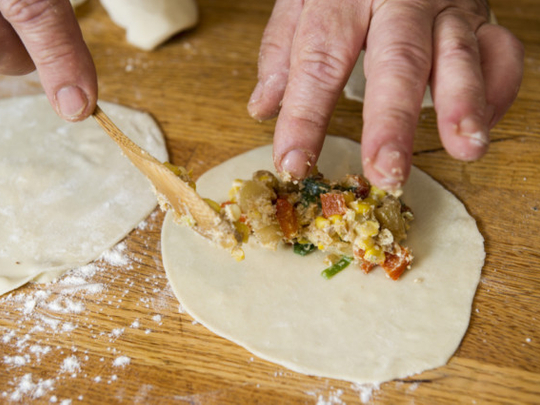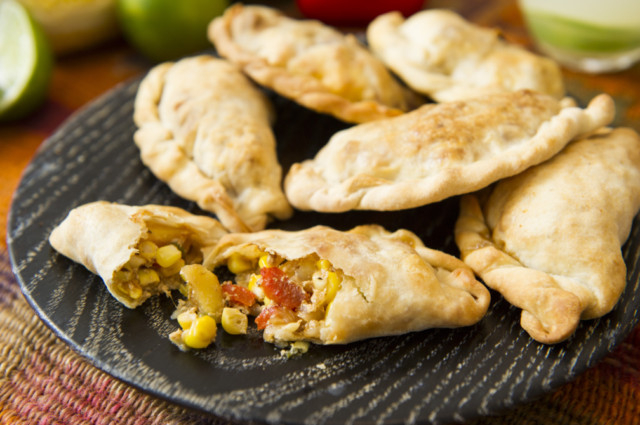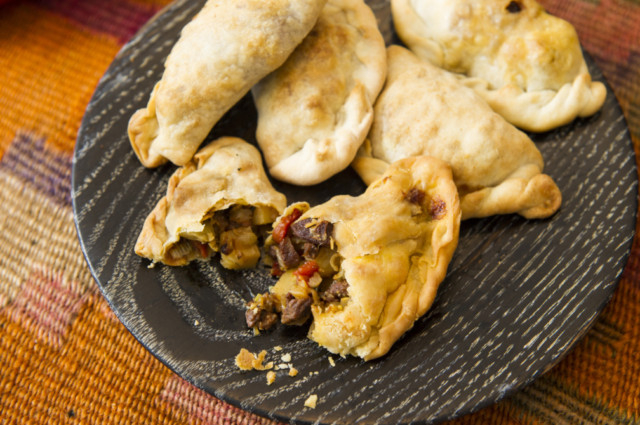
The empanada is the little meat pie that could — a native of Spain that travelled the world, touching down in Latin America, the Caribbean, Eastern Europe, Africa, South Asia and the British Isles.
Each culture put its spin on the idea, creating the humble Cornish pasty, the flaky French chausson, the highly spiced Indian samosa, the peppery Jamaican patty and the phyllo-wrapped Middle Eastern borek, not forgetting the gut-filling peripatetic knish. And that’s only scratching the surface.
May I share a personal empanada reverie? I still dream about a Mexican version I once sampled on the plaza in Oaxaca. It was made to order by a local woman, who baked it on a clay comal set over burning coals. She had simmered chicken in a complex yellow mole sauce, and as she wrapped the filling in a dough of masa harina, she added a strip of hoja santa, a sweet leafy herb with a mysterious fragrance. Just the thought of it has my mouth watering.
But if there is an empanadas capital of the world, it is Argentina. The entire population is crazy for them. (For that matter, empanadas proliferate in Uruguay, too, and folks there also lay claim to consuming the most per capita.)
The Argentine empanada is diminutive, just two or three delicious bites. It is eaten throughout the day — as an afternoon snack or an appetizer before a big Porteño feast of multiple-choice meats from the grill, with a beverage from Mendoza. Everyone expresses a preference, baked or fried. Both ways are good.
My friend Fernando Trocca, a well-known chef in Argentina, showed me how to make them when I was in Buenos Aires. He first made a few savoury fillings: a flavourful stir-fry of hand-chopped beef with green olives; a creamy concoction of sweet corn called humitas; and mondongo, spicy stewed tripe, which we agreed was divine.
Juliana López May, another chef, tutored me in the art of creating the empanada’s exterior. First, we made a traditional dough with flour, salt and boiling water. Once we rolled it to the proper thickness and cut it into little circles, a spoonful of filling was placed on each round. The technique to master was holding the open empanada with one hand and using the other hand to crimp the outer edge and form a decorative braid. Less dexterous people use a fork, she told me.
She made it look easy. With her deft hands, each little pie was swiftly pinched to perfection, and a large batch was ready for the oven in no time.
BEEF EMPANADAS
Time: 11/2 hours
Yield: 36 empanadas
For the dough
113g butter, plus more for brushing tops
11/2 tsp fine sea salt
750g all-purpose flour, about 6 cups, more as needed
For the filling:
454g beef chuck, in 1/8-inch dice (or very coarsely ground)
Salt and pepper
Olive oil for sautéing
1 cup diced onion
227g potatoes, peeled and diced
4 garlic cloves, mashed to a paste
2 tsp chopped thyme
2 tsp chopped marjoram or 1 tsp oregano
1 tbs tomato paste
1 tbs pimentón dulce or paprika
Large pinch cayenne
Beef or chicken broth, as necessary, or use water
1/2 cup chopped scallions, white and green parts
1/4 cup chopped pitted green olives
2 hard-cooked eggs, sliced
Make the dough: Put 2 cups boiling water, 113g butter and 1 1/2 tsp salt in large mixing bowl. Stir to melt butter and dissolve salt. Cool to room temperature.
Gradually stir in flour with a wooden spoon until dough comes together. Knead for a minute or two on a floured board, until firm and smooth. Add more flour if sticky. Wrap and refrigerate for one hour.
Make the filling: Season chopped beef generously with salt and pepper and set aside for 10 minutes. Melt 3 tbs butter in a wide heavy skillet over medium-high heat. Add beef and fry until nicely browned, stirring throughout to keep pieces separate, about 5 minutes.
Turn heat down to medium and add onion. Keep turning mixture with a spatula, as if cooking hash, until onion is softened and browned, about 10 minutes. Add potatoes, garlic, thyme and marjoram and stir well to mix. (Add a little more butter to pan if mixture seems dry.) Season again with salt and pepper and let mixture fry for 2 more minutes. Stir in tomato paste, pimentón and cayenne, then a cup of broth or water. Turn heat to simmer, stirring well to blend any caramelised bits.
Cook for about 10 more minutes, until both meat and potatoes are tender and the sauce just coats them — juicy but not saucy is what you want. Taste and adjust seasoning for full flavour (intensity will diminish upon cooling). Stir in scallions and cool to room temperature, then cover and refrigerate until ready to use.
Divide chilled dough into 28g pieces and form into 2-inch diameter balls. Roll each piece into a 41/2-inch circle. Lay circles on a baking sheet lightly dusted with flour.
Moisten outer edge of each round with water. Put about 2 tbs filling in the centre of each round, adding a little chopped green olive and some hard-cooked egg to each. Wrap dough around filling to form empanada, pressing edges together. Fold edge back and finish by pinching little pleats or crimping with a fork.
Heat oven to 375 degrees. Place empanadas on parchment-lined or oiled baking sheet, about 1 inch apart. Brush tops lightly with butter and bake on top shelf of oven until golden, 10 to 15 minutes. Serve warm.
CORN EMPANADAS
Time: 11/2 hours
Yield: 36 empanadas
For the dough
113g butter, plus more for brushing tops
11/2 tsp fine sea salt
750g all-purpose flour, about 6 cups, more as needed
For the filling
Olive oil, for sautéing
1 cup diced onion
227g potatoes, peeled and diced
2 cups fresh corn kernels
2 garlic cloves, mashed to a paste
1 tsp cumin seeds, toasted and ground
2 tsp chopped thyme
Salt and pepper
Chicken broth, or use water
2 red bell peppers, roasted till blackened, then peeled and diced
1/2 cup ricotta
Large pinch cayenne
57g grated Gruyere cheese
1/2 cup chopped scallions, white and green parts
Make the dough: Put 2 cups boiling water, 113g butter and 11/2 tsp salt in a large mixing bowl. Stir to melt butter and dissolve salt. Cool to room temperature.
Gradually stir in flour with a wooden spoon until dough comes together. Knead for a minute or two on a floured board, until firm and smooth. Add more flour if sticky. Wrap and refrigerate for one hour.
Make the filling: Melt 3 tbs butter in a wide heavy skillet over medium-high heat. Add onion and cook briskly, stirring, until softened and lightly browned, about 10 minutes. Add potatoes, corn, garlic, cumin and thyme. Season generously with salt and pepper and stir well. Add one cup broth or water and simmer until potatoes are softened and liquid has evaporated, 5 to 7 minutes.
Transfer mixture to a large bowl. Add roasted peppers, ricotta and cayenne. Stir well. Taste and adjust seasoning (flavour intensity will diminish upon cooling). Stir in Gruyere and scallions. Cool to room temperature, then cover and refrigerate until ready to use.
Divide chilled dough into 28g pieces and form into 2-inch diameter balls. Roll each piece into a 41/2-inch circle. Lay circles on a baking sheet lightly dusted with flour.
Moisten outer edge of each round with water. Put about 2 tbs filling in the centre of each round. Wrap dough around filling to form empanada, pressing edges together. Fold edge back and finish by pinching little pleats or crimping with a fork.
Heat oven to 375 degrees. Place empanadas on parchment-lined or oiled baking sheet, about 1 inch apart. Brush tops lightly with butter and bake on top shelf of oven until golden, 10 to 15 minutes. Serve warm.
Note: Dough and filling each may be made up to 2 days ahead. Empanadas may be assembled several hours ahead; refrigerate, uncovered. Bring to room temperature before baking.
— New York Times News Service













